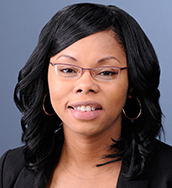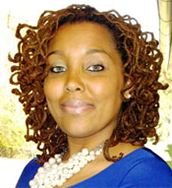Article examines racially skewed school discipline, proposes initial solutions
LAWRENCE — In 2015, a black female high school student in South Carolina was slammed to the floor and dragged out of a classroom by a white sheriff’s deputy in a case that made national headlines. Since then, police shootings of unarmed black Americans and incidents of law enforcement being called on black citizens for trivial reasons regularly make the news. Such cases are only a few examples of what black students, especially female youths, face in American schools, often at the hands of police and vague disciplinary policies. A University of Kansas professor has co-authored a scholarly article examining how such skewed school discipline policies have long-term effects for students and how educators can address the problem in intentional, sustainable ways.
 When the Spring Valley High School student was slammed to the floor, a classmate happened to catch the incident on video. Both students were suspended, and both were black girls. Those incidents and other minor events often referred to as “microaggressions” are staggeringly common. When taken together, these incidences against black girls and students of color form what could more accurately be called anti-black aggression, according to Dorothy Hines, assistant professor of African & African American studies and curriculum & teaching.
When the Spring Valley High School student was slammed to the floor, a classmate happened to catch the incident on video. Both students were suspended, and both were black girls. Those incidents and other minor events often referred to as “microaggressions” are staggeringly common. When taken together, these incidences against black girls and students of color form what could more accurately be called anti-black aggression, according to Dorothy Hines, assistant professor of African & African American studies and curriculum & teaching.
“This is not just criminalization of people of color, but something else. People of color will see these incidents such as the Spring Valley example, but they also exist in other, less overt ways,” Hines said. “But much of what is happening is not on a microlevel and can have long-term effects.”
 Hines and co-author Jennifer Wilmot, KU doctoral student in educational leadership & policy studies, use the Spring Valley High School incident as an illustration of larger trends in their article, published in the journal Multicultural Perspectives. In that incident, the student was asked to put away her cellphone, and when it was not put away she was then assaulted by an officer. School personnel cited a state policy, the "disturbing schools" law, in defending the officers’ actions. The law was amended in 1976 to apply to all schools and colleges in South Carolina, making it unlawful to disrupt school activities. The law has frequently been cited in school referrals that on a statewide level have disproportionately been used against black youths. In fact, a 2016 lawsuit pointed out black students were nearly four times more likely to be referred for charges under the law than their white peers. The South Carolina Senate introduced a bill last year to narrow the focus of the law, but the punitive effects of the Spring Valley High School case still resonate.
Hines and co-author Jennifer Wilmot, KU doctoral student in educational leadership & policy studies, use the Spring Valley High School incident as an illustration of larger trends in their article, published in the journal Multicultural Perspectives. In that incident, the student was asked to put away her cellphone, and when it was not put away she was then assaulted by an officer. School personnel cited a state policy, the "disturbing schools" law, in defending the officers’ actions. The law was amended in 1976 to apply to all schools and colleges in South Carolina, making it unlawful to disrupt school activities. The law has frequently been cited in school referrals that on a statewide level have disproportionately been used against black youths. In fact, a 2016 lawsuit pointed out black students were nearly four times more likely to be referred for charges under the law than their white peers. The South Carolina Senate introduced a bill last year to narrow the focus of the law, but the punitive effects of the Spring Valley High School case still resonate.
“I was taken aback not just by the violence of that case but by the degree of silencing that happened,” Hines said. “The disturbing schools law has been around for generations, but it was never really reassessed in court.”
Such policies are all too common in American schools, Hines and Wilmot write. When policies and state laws do not clearly set guidelines, are said to be race-neutral but are actually racially biased, inequality arises. Research has shown for years that black students are disciplined, suspended and expelled at much higher rates than their peers. However, such schoolwide and state-level discipline data do not make their way to the teachers and administrators who overdiscipline the youths.
The first step in addressing such disparities is acknowledging there is a problem. In her experience as a high school teacher, Hines saw many fellow teachers who were not aware of racial disciplinary disparities in their own classrooms. Making such data available to teachers and administrators would go a long way to helping people understand that it is happening and consider how it could be addressed.
“While we know this is happening, we are still trying to prove to educators that it is happening,” Hines said. “We have to get people data. I think there is great utility in getting that information to people who are making policy and decisions for our schools. Students are capturing discipline data on their cellphones. They are showing the actual video of what is happening and not just relying on the numbers. Not only do we not know the data and the numbers, we do not want to believe video recordings of the misuse of authority even when we have seen it with our own eyes. We have to realize that these incidents of bias are occurring.”
Addressing policies and laws on the books is a necessary second step in addressing unequal and inhumane discipline of black students, the authors argue. An understanding of which rules are not being enforced equally, which are unclear or are being enforced subjectively is necessary as well. Currently, students can go through school with multiple disciplinary policies, not knowing which will be applied to them in any situation.
Third, it is necessary to address the role of police in school discipline. Officers are often used unnecessarily, and situations can escalate to violence too quickly. Better training for officers in de-escalation of what often is an educator’s lack of cultural responsiveness could also help address current problems in school. But ultimately there should be a primary focus on decriminalizing schools for black girls and the removal of policing altogether.
“Police are being used as a threat to students, and we have to address this issue between schools and police,” Hines said. “Many school officers are not trained in racial equity or related issues.”
Finally, giving dignity back to black students and ensuring teachers and administrators respond to the academic and socioemotional needs of black girls could help address the problem as well. There is often a knowledge gap in what happens between an incident and the carrying out of discipline. School personnel might not know what happens after a student is arrested, especially if they have no experience with jails or the stigma that comes with being arrested. Many educators are not familiar with the concept of a school-to-prison pipeline or how their classrooms can in themselves operate as a prison.
“If there is a gap in knowledge, we can’t be surprised by the outcomes being unequal,” Hines said. “We have to address that there’s a problem that exists and policies that we’re enforcing are outdated.”
Finally, educators can address anti-black aggressions in schools by preparing future teachers with contextual examples of education, exposure to diverse communities, diverse faculty and students, and making sure they understand their role in facilitating learning rather than controlling students or using racially biased practices.
“We have to be honest with students about what teaching is and what teaching is about,” Hines said. “I think we have to make it real to students about what they’ll be facing in their classrooms. They need to know what a day in the life of a teacher will be and the impact that their actions will have on their students.”